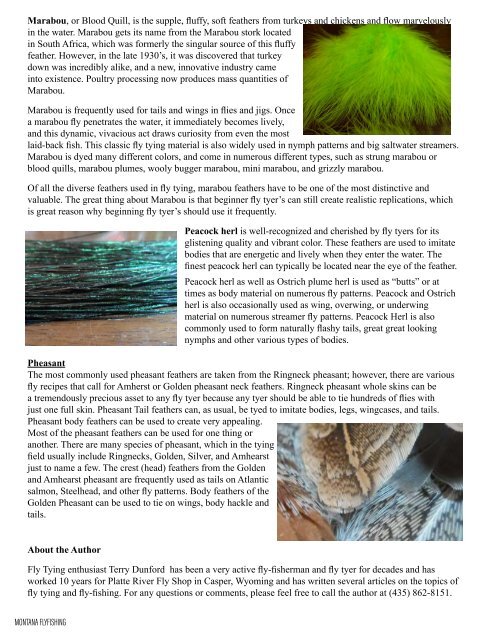Spring 2018
Montana Fly Fishing Magazine is the FREE digital magazine devoted to fly fishing in the great state of Montana.
Montana Fly Fishing Magazine is the FREE digital magazine devoted to fly fishing in the great state of Montana.
Create successful ePaper yourself
Turn your PDF publications into a flip-book with our unique Google optimized e-Paper software.
Marabou, or Blood Quill, is the supple, fluffy, soft feathers from turkeys and chickens and flow marvelously<br />
in the water. Marabou gets its name from the Marabou stork located<br />
in South Africa, which was formerly the singular source of this fluffy<br />
feather. However, in the late 1930’s, it was discovered that turkey<br />
down was incredibly alike, and a new, innovative industry came<br />
into existence. Poultry processing now produces mass quantities of<br />
Marabou.<br />
Marabou is frequently used for tails and wings in flies and jigs. Once<br />
a marabou fly penetrates the water, it immediately becomes lively,<br />
and this dynamic, vivacious act draws curiosity from even the most<br />
laid-back fish. This classic fly tying material is also widely used in nymph patterns and big saltwater streamers.<br />
Marabou is dyed many different colors, and come in numerous different types, such as strung marabou or<br />
blood quills, marabou plumes, wooly bugger marabou, mini marabou, and grizzly marabou.<br />
Of all the diverse feathers used in fly tying, marabou feathers have to be one of the most distinctive and<br />
valuable. The great thing about Marabou is that beginner fly tyer’s can still create realistic replications, which<br />
is great reason why beginning fly tyer’s should use it frequently.<br />
Peacock herl is well-recognized and cherished by fly tyers for its<br />
glistening quality and vibrant color. These feathers are used to imitate<br />
bodies that are energetic and lively when they enter the water. The<br />
finest peacock herl can typically be located near the eye of the feather.<br />
Peacock herl as well as Ostrich plume herl is used as “butts” or at<br />
times as body material on numerous fly patterns. Peacock and Ostrich<br />
herl is also occasionally used as wing, overwing, or underwing<br />
material on numerous streamer fly patterns. Peacock Herl is also<br />
commonly used to form naturally flashy tails, great great looking<br />
nymphs and other various types of bodies.<br />
Pheasant<br />
The most commonly used pheasant feathers are taken from the Ringneck pheasant; however, there are various<br />
fly recipes that call for Amherst or Golden pheasant neck feathers. Ringneck pheasant whole skins can be<br />
a tremendously precious asset to any fly tyer because any tyer should be able to tie hundreds of flies with<br />
just one full skin. Pheasant Tail feathers can, as usual, be tyed to imitate bodies, legs, wingcases, and tails.<br />
Pheasant body feathers can be used to create very appealing.<br />
Most of the pheasant feathers can be used for one thing or<br />
another. There are many species of pheasant, which in the tying<br />
field usually include Ringnecks, Golden, Silver, and Amhearst<br />
just to name a few. The crest (head) feathers from the Golden<br />
and Amhearst pheasant are frequently used as tails on Atlantic<br />
salmon, Steelhead, and other fly patterns. Body feathers of the<br />
Golden Pheasant can be used to tie on wings, body hackle and<br />
tails.<br />
About the Author<br />
Fly Tying enthusiast Terry Dunford has been a very active fly-fisherman and fly tyer for decades and has<br />
worked 10 years for Platte River Fly Shop in Casper, Wyoming and has written several articles on the topics of<br />
fly tying and fly-fishing. For any questions or comments, please feel free to call the author at (435) 862-8151.<br />
MONTANA FLYFISHING




